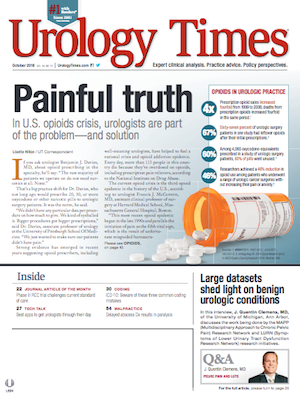Publication
Article
Urology Times Journal
PSA isoform assay predicts high-grade PCa
Author(s):
Results of a prospective, multicenter study validate the clinical performance of a PSA isoform assay (IsoPSA) for predicting high-grade prostate cancer, Eric A. Klein, MD, reported at the AUA annual meeting in San Francisco.
San Francisco-Results of a prospective, multicenter study validate the clinical performance of a PSA isoform assay (IsoPSA) for predicting high-grade prostate cancer, Eric A. Klein, MD, reported at the AUA annual meeting in San Francisco.
“Current assays that measure PSA are prostate specific but not cancer specific, and therefore, they lead to a lot of unnecessary biopsies,” said Dr. Klein, Andrew C. Novick Distinguished Chair, Glickman Urological and Kidney Institute, and professor of surgery, Lerner College of Medicine of Cleveland Clinic, Cleveland.
“The IsoPSA assay is a novel biomarker that predicts cancer risk based on measuring the structure rather than the concentration of prostate cancer-specific isoforms. We believe that its use as a reflex test is likely to reduce over-detection of low-grade cancer and also the rate of unnecessary biopsies by an estimated 47%.”
Using a small sample of blood placed into a proprietary aqueous solution, IsoPSA measures PSA isoforms that arise because the disordered metabolism of cancer cells results in molecular truncation and glycosylation, causing changes in physical structure.
Its performance for predicting Gleason grade ≥7 disease was demonstrated in an initial study that included 261 men with PSA ≥2 ng/mL who were undergoing prostate biopsy within 30 days. The prevalence of high-grade disease in the study population was 33.7%, and the PSA isoform test had an area under the curve (AUC) of 0.81 for predicting Gleason grade ≥7, 96% sensitivity, and a negative predictive value (NPV) of 95%. The AUC for total PSA was 0.68, and there was no relationship between the IsoPSA value and serum PSA.
“A lot of men in the study cohort who had a very low PSA would be considered at high risk for having high-grade disease based on their IsoPSA result,” Dr. Klein said.
The validation study included 271 men with a PSA ≥2 ng/mL who had blood obtained within 30 days prior to prostate biopsy; the prevalence of high-grade disease in this cohort was 29.5%. The performance of IsoPSA in the validation study was statistically similar to the preliminary analysis. The AUC for predicting Gleason grade ≥7 disease was 0.79, and the test’s sensitivity and NPV were both 93%. The AUC for total PSA was 0.66.
Next: Assay performs better in men undergoing MRI-guided BxAssay performs better in men undergoing MRI-guided Bx
Dr. Klein pointed out that the percentage of men undergoing magnetic resonance imaging-ultrasound fusion biopsy was higher in the validation study than in the initial study (42% vs. 4%). A subgroup analysis in the validation cohort with men categorized by biopsy type (MRI-guided or transrectal ultrasound) showed the assay performed better in men undergoing an MRI-guided biopsy than in those having a transrectal ultrasound-guided biopsy both for predicting the presence of any cancer (AUC 0.82 vs. 0.78) and Gleason grade ≥7 disease (AUC 0.86 vs 0.83).
“One would expect that a test that predicts the presence of high-grade disease should perform better when it is used in men who undergo biopsy with a technique that is more likely to find high-grade disease, and in fact, it did,” said Dr. Klein.
Results of a multivariable analysis found that the IsoPSA result was the only variable that independently predicted Gleason grade ≥7 disease in both the initial and validation studies. Age was a significant variable in the initial study only, and there were no significant associations between presence of high-grade disease and total PSA, prostate volume, or race in either study.
Read: SBRT shows long-term efficacy for low-, intermediate-risk PCa
“This finding suggests that IsoPSA will be a very simple test to use,” Dr. Klein said.
Based on the findings from the initial and validation studies, Dr. Klein proposed a screening algorithm in which IsoPSA would be ordered as the next step for all men with a worrisome total serum PSA. Men with a negative IsoPSA would be monitored while those with a positive test result would be considered candidates for MRI-ultrasound fusion biopsy.
“The role of MRI-ultrasound fusion biopsy for prostate cancer detection in the setting of PSA screening is controversial, in part because it misses about 20% of high-grade disease. I would argue that a biopsy is justified in a patient who tests positive with an assay that has high sensitivity for detecting the presence of Gleason grade 7 or higher prostate cancer, even if the MRI is negative,” he said.
Cleveland Clinic has a financial interest in Cleveland Diagnostics, which owns the intellectual property for IsoPSA with AnalizaDx. Genomic Health has licensed this intellectual property for commercial development.

Newsletter
Stay current with the latest urology news and practice-changing insights — sign up now for the essential updates every urologist needs.























